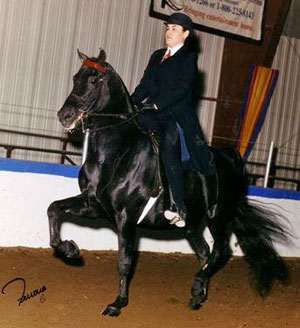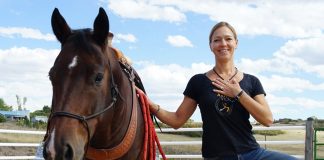
Note: This is day 26 of my 30-day blogging challenge. What the heck is a 30-day blogging challenge? Read about it here.
My meandering equestrian path has taken me away from saddle seat, and I look back on it now the way people who grew up in small towns and moved to big cities often look back at their homes. From a distance, I can see how backwards it looks from an outsider’s perspective. At the same time, I still have positive feelings about it and I know from firsthand experience that a lot of what people think about it is completely wrong. I’ve ended up in this very contrary position where I always feel compelled to defend saddle seat from its detractors while at the same time pointing out its flaws—though often silently, in my head—when its fans celebrate it.
So here I am with a few days of self-mandated daily blogging left to go. Why not use one to lay out all my feelings about my former equestrian sport of choice? Before I proceed, let me clarify that when I talk about saddle seat, I’m speaking specifically of the saddle seat breeds governed by the USEF: Arabians, Morgans and American Saddlebreds. I don’t have experience with Tennessee Walkers or other gaited breeds, so I can’t really speak firsthand about them. And on that note, my first thought on saddle seat…
Trotting Horses Aren’t Sored.
I just have to put this out there upfront because every time an image of a horse picking its feet up high appears somewhere on the Internet, someone will insist that the horse is sored. As I understand it, a sored horses have a noticeable head bob. Lots of head/neck movement is expected at the running walk; at the trot, it’s evidence that the horse is lame. If soring could make horses trot higher, reiners stop better, jumpers jump higher or dressage horses piaffe correctly, it would be a problem in every discipline. But it happens to be a disturbing method that only works to get a specific result on a specific type of horse. So please stop accusing trotting horse trainers of soring. They aren’t doing it.
The Tails Aren’t Broken.
Second most common comment on saddle seat horses, specifically Saddlebreds, is that their tails are broken. They aren’t. A veterinarian performs a relatively simple surgery where two small incisions are made to muscles on the underside of the tail, then the tail is put in a set that holds it upright so that it heals in the higher carriage. This can actually be done without the surgery, but it takes a lot of time and patience to manually stretch the tail over time. Either way, the horses can still swish their tails. Please read that again. They can still swish their tails. The muscles still work. People refuse to believe this, but I think maybe anyone who doubts it can go clean out the hind feet of a barn full of Saddlebreds during the height of fly season and see how many times they get a tail to the face. Then come back and tell me about how the tails are “broken.”All that being said…
I Really Hate Set Tails.
I don’t think tail setting causes serious pain or lasting damage, but COME ON, Saddlebred world. Literally everyone else in the horse world looks at those set tails and sees a symptom of equine abuse for vanity’s sake. It doesn’t matter that it’s not abusive: Perception is reality. Just ban set tails. No one is going to leave the breed because the horses’ tailbones aren’t sticking straight up in the air anymore. In fact, you might win some new fans. Besides, when you’re sitting in the saddle having the ride of your life, you can’t see the tail. Who cares what it’s doing back there? (I know, I know. Judges look at the overall picture. But if everyone has a natural tail, no one’s at a disadvantage.)(Sidenote: Tail sets are technically illegal for Morgans and Arabians and judges are supposed to penalize the appearance of a set tail. Do they? Some probably do.)
That Is How They Move.
If you visit a breeding farm that specializes in saddle seat type horses, you will see weanlings trotting around the field with their heads up, picking their feet up high. You’ll see old campaigners and retired broodmares doing the same if the wind blows just right and they’re feeling good. People from other breeds look at that upright carriage and label it an artificial frame. And they would be right, if you tried to stuff a Quarter Horse into it. But this is really what these horses are bred for, and in that respect, it’s no less natural than any other horse sport. Except…
The Shoes…
Weighted, padded shoes are another big drag on the sport, in my opinion. I don’t think they’re inherently cruel. Proportional to the horse’s weight, a Saddlebred show shoe is lighter than an average sneaker is to you. The real problem with show shoes (again, in my opinion) is that you can’t really turn a horse out when he’s wearing them. The risk is too high that if he gets running around he’ll throw that heavy shoe—and potentially take a chunk of hoof wall with it. So, the horses generally stay stalled during show season when they aren’t being worked. Now, top-level show horses in any discipline aren’t living out in a vast field 24/7, but at least if your show horse is wearing unweighted shoes you have the option of giving him a couple of hours in a paddock, and that’s better than nothing.Thing is, these horses are natural high steppers (see point No. 4.) If weighted shoes and stacked pads were outlawed across the board, you’d get to see that movement in the show ring, and no one would be at a disadvantage if everyone was subject to those rules. Why can’t we have that?
It Doesn’t Have to Be Like This, and It Often Isn’t.
If all this talk of weighted shoes and tail sets and full-time stabling is making you angry, just keep in mind that I’m speaking of the upper echelon of the sport. If you ride a horse in the pleasure divisions (Country Pleasure for Arabians and Saddlebreds or Classic Pleasure for Morgans) the expectations are a bit less specialized. There are limits on the shoes, the tails aren’t set, and in theory, the horse should be able to exit the show ring and immediately hit the trails. And if you’re showing locally, not aiming for your breed’s national championship, you absolutely don’t have to do any of that stuff. You can have a horse who’s turned out all day and goes on trail rides, and then is a competitive saddle seat show horse on the weekend. Snoopy and I did it for years and many of my friends from the circuit did the same.Basically, if you’re at all interested in riding saddle seat, don’t be scared off by what other people are telling you. It’s probably not entirely true.
I have a part two of this post currently brewing in my brain about where I think the saddle seat world is really getting it right, and that’s in its academy program. More on that later.
Have you ever tried riding saddle seat? Would you? Do you want to tell me about how I’m WRONG about Saddlebred tails not being broken? This is what the comments section is for, my friends. Lay it all out below.
Back to The Near Side






I would love to try riding saddle seat. I live in the middle of gaited horseland, USA, and see Walkers, Spotted Saddle Horses and Racking Horses all around. I like to watch the Saddlebreds and Morgans on YouTube too.
Tell it sister.I grew up with quarter horses , t-breds warmbloods.I live in ky.I have worked with many of the most famous saddlebred trainers and they are all very good horsemen.Never have I seen anything approaching abuse.Who would abuse a horse worth a million dollars.? I’ve actually carried the check and delivered the horse on several occasions.There isn’t a top level show horse in any discipline that is totally natural.well, maybe grand prix jumpers. Thanks for the true story.
Good point about the padded weights, and something quite a few people in the industry lament. At least one reader called out the issue on our blog – http://thejodhpurscompany.com/blogs/the-jodhpurs-company-blog/19118995-the-five-most-common-equitation-mistakes-and-how-to-avoid-them.
It will be interesting to see if the ASHA responds with a sport-wide ban anytime soon.
As someone who has ridden the”a.” Circuit for 10 years in 3 gaited show pleasure and 5 gaited , I would like to add one more thing. At the high level show barns they do not want you to interact with your horse. Most give 1 20 to 25 minute lesson a week. They want to tack your horse and groom it for you.
The less you handle your horse the less you understand it. Ha, just ask if you can ride it on a flat trail and see what happens.
The trainers are trying to keep total control so the animal performs its best. That is sacrificing the riders progress. More blue ribbons, less accomplished riders.
Too bad.
I would love to see saddleseat go in the direction of showing the horse in a more natural form. If the horse does all these things naturally, then the high heeled weighted shoes and the long shanked curb bits and all this shouldn’t be required. I rehabbed a saddlebred who was completely ruined by her training and took a very long time to trust humans again. Maybe not all saddleseat trainers are bad, but there are a few bad apples just like in every discipline. This particular horse wouldn’t let you anywhere near her back end without throwing hooves in your direction and kicking the walls in the cross ties because she had had her tail caged. For anyone that doesn’t know what tail setting is, here’s a photo of one: https://www.google.ca/url?sa=i&rct=j&q=&esrc=s&source=images&cd=&cad=rja&uact=8&ved=0ahUKEwjWi4SXus7QAhVM0GMKHa7kC2kQjRwIBw&url=http%3A%2F%2Ffreedmanharness.com%2Fcollections%2Fprice-asc-tail-setting&bvm=bv.139782543,d.cGc&psig=AFQjCNEL–X5Y-uFBK22JlQN-aNC7jZxwQ&ust=1480525593316502 Also if you look at x-rays of the horse’s hoof in a normal shoe vs a weighted shoe, you’ll see that the angle for the coffin bone is incorrect, setting the horse up for soreness and soundness issues later in life. If saddleseat (and any discipline) is going to be accepted by the horse world, it needs to put the welfare of the horse first.